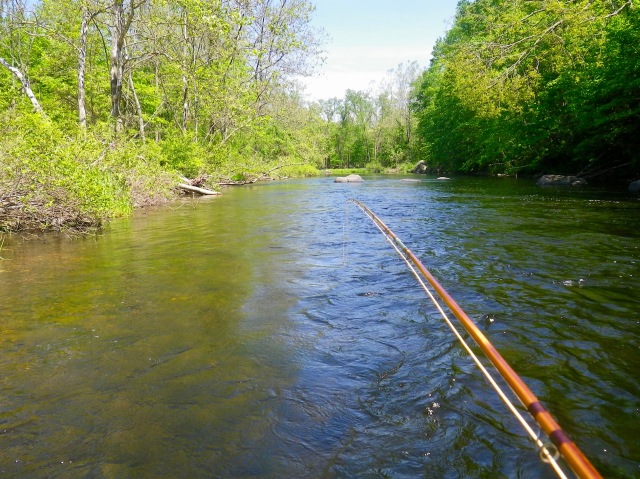I’ve been getting a lot of wet fly questions, and I thought I’d share my answers with the group. I’m excited that so many of you are interested in this ancient and traditional art. So here we go:
Q: What size and length rod are you using on the Farmington? A: My dedicated wet fly stick is a 10-foot 5-weight Hardy Marksman II. I don’t hate it, I don’t love it. It’s got a good backbone for helping manage bigger trout in snotty currents, but I wish it were a bit softer in the flex. What’s important is that it’s a 10-footer, which I find useful for mending. Note: I still take the 7’9″ Tonka Queen out for an occasional wet fly jaunt, albeit in moderate/slow currents. That cane pole is a dream for mending.
The Queen in action. This rod gives me an ultra-fine level of line control.

Q: Do you use an indicator? A: My joke answer is “yes” — the splash of the take, the spray of water, and the jolt of the rod tip all indicate a strike. The real answer is no, not in the traditional sense. The vast majority of time, you need no visual aid to tell you the fish has taken the fly. An exception would be when you’re fishing upstream, drawing the line toward you as the rig moves downstream. I’m watching the tip of the line like a hawk for stalls, shudders, or stoppage that would indicate a delicate strike well below the surface.
Q: Do you use a floating line? A: Yes. (I’m a line control freak.)
Q: When you’re casting and mending, is it basically a dead drift, then the flies start swinging and rising? A: Kindof. Unless you introduce slack into the presentation, you’ll never really have a true dead drift. So even when I’m doing a quartering down or straight across cast and mend, the flies are moving downstream and across, albeit in a slower manner than they would with a traditional wet fly swing.
Q: You’ve said that in spring, you focus more on pool-type water, and faster water in the summer. I’m having trouble finding the right type and depth of water. Any advice? A: Generally speaking, the colder it is, the greater the chance that trout will be in deeper pool-type water. That doesn’t mean you won’t find trout in 1-foot deep riffles in December. The bottom line is: there is no substitute for experience on the water. Get out and explore. Keep a log. Where and when did you fish? Were you catching? Were others catching? What was the weather like? What was the water height? You can see where this is going. And finally, a wee plug for myself: take a lesson. I hear this a lot from clients: “I’ve driven past this spot a hundred times and never thought to fish it.”
Q: I fished wet flies and only had one bump. What was I doing wrong? A: (This person was out on the Farmington this week.) You’ve got a lot of elements working against you. For starters, I don’t like to fish wets in the Permanent TMA in any flow over 500cfs (it’s been 750cfs and higher). 250cfs-400cfs is the wheelhouse. Hatch windows also have a lot to do with the wet fly bite. For example, right now (Hendrickson and caddis hatches) you want to be swinging anywhere from 11am to 3pm-ish. You’re trying to entice the trout that are taking the emergers. And this cold, wet weather isn’t helping, either.
When you hit the emergence just right, the results can be magical.

Keep on swinging.
I use essentially the same rod, especially in heavy water. I have found that a DT Floating line works great for mending the drift with your leader setup. Not to mention roll casting when up against the trees!
Finding what works for you is important. 🙂
Steve, Great content really appreciate it!
Thanks, John. I appreciate your feedback.